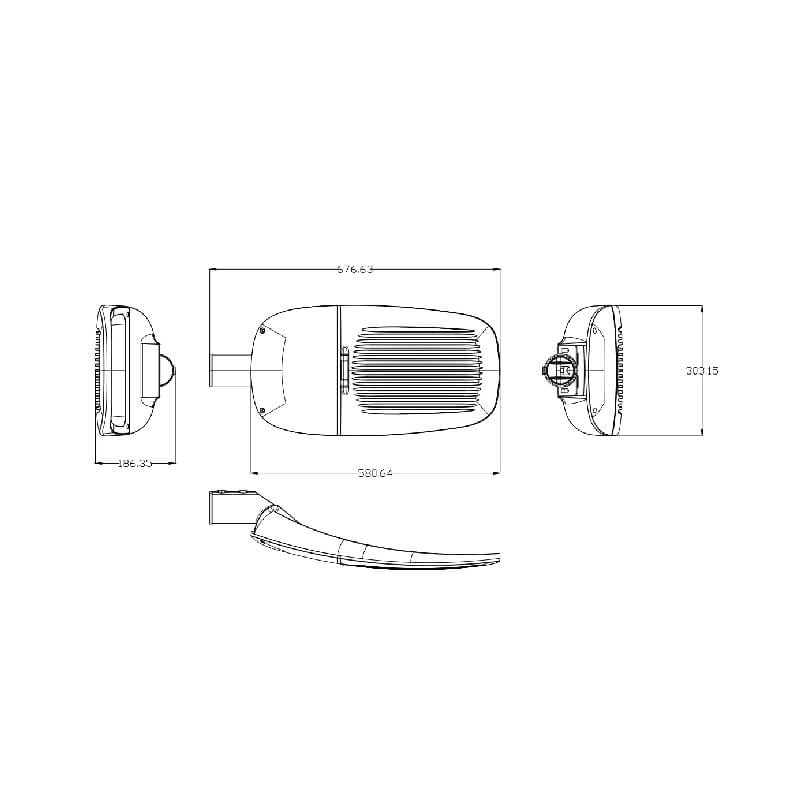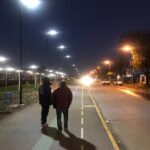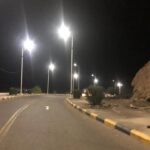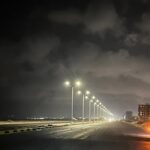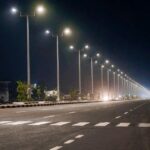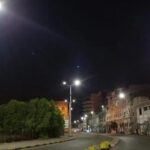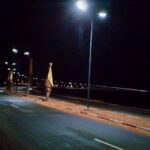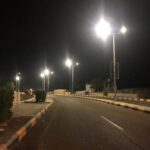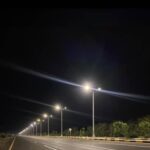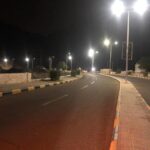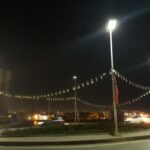The solar street light housing stands as a pivotal element within the intricate framework of solar illumination systems, often overshadowed by the prominence of its more visible counterparts. The housing serves as the protective shell encompassing vital components, shielding them from environmental hazards while facilitating optimal functionality. Despite its significance, the intricacies and innovations within solar street light housing remain relatively unexplored. We aim to change this. Let’s shed some light on the often-overlooked domain of the solar street light housing.

Why is the solar street light housing important?
Why is the housing crucial?
- Protection of other components: The housing encases crucial components such as the solar panel, battery, LED fixture, and electronics, shielding them from harsh environmental elements.
- Durability and Longevity: A robust housing ensures the durability and longevity of the solar street light system. It helps prevent damage from weather conditions, physical impact, and vandalism.
- Optimal Performance: It helps maintain the efficiency of the solar panel, the capacity of the battery, and the luminosity of the LED light, ensuring reliable operation throughout the night.
- Safety and Reliability: The housing reduces the risk of electrical hazards, short circuits, and other malfunctions, enhancing the overall safety of the lighting infrastructure.
Solar Street Light Housing Design Considerations
When designing solar street light housings, several key considerations must be addressed to ensure optimal functionality. Firstly, the material selection plays a crucial role in determining the longevity and performance of the housing. Engineers often opt for weather-resistant materials such as aluminum or stainless steel to withstand outdoor conditions and prevent corrosion over time.
In addition, the design should prioritize efficient heat dissipation to prevent overheating of the internal components, particularly the LED lights and battery systems. Incorporating heat sinks or ventilation channels within the housing can help dissipate heat effectively, ensuring consistent performance and extending the lifespan of the components. The design must also account for the integration of photovoltaic panels onto the housing structure. Proper positioning and orientation of the solar panels are essential to maximize sunlight exposure and optimize energy generation.
Another critical aspect to consider is the ingress protection (IP) rating of the housing, which determines its resistance to dust, water, and other environmental contaminants. A higher IP rating ensures greater protection against moisture ingress, prolonging the life of sensitive electronic components and reducing maintenance requirements.
Moreover, the design should prioritize ease of installation and maintenance to facilitate deployment in various urban or rural settings. Modular designs with accessible compartments for component replacement and straightforward mounting systems can simplify installation and servicing, reducing downtime and associated costs.
Types of Housing Designs
There are various designs you can choose from and these include:
- Aluminum Alloy Housing: Crafted from durable aluminum alloy, this type of solar street light housing offers exceptional strength and corrosion resistance. Its lightweight nature ensures easy installation and maintenance, while its robust construction provides protection against harsh weather conditions.
- Stainless Steel Housing: Known for its longevity and resistance to rust and corrosion, stainless steel solar street light housing is ideal for applications requiring durability in challenging environments. Its sleek appearance adds a modern touch to urban landscapes while ensuring long-term reliability.
- Die-cast Aluminum Housing: Engineered for superior heat dissipation and structural integrity, die-cast aluminum housing offers optimal protection for solar street lights. Its rugged design enhances durability, making it suitable for high-traffic areas and environments with extreme temperatures.
- Polycarbonate Housing: Designed for maximum impact resistance and UV stability, polycarbonate housing provides reliable protection for solar street lights in outdoor settings. Its lightweight and transparent properties allow for efficient light transmission, ensuring effective illumination while withstanding harsh weather conditions.
- Composite Housing: Combining strength and versatility, composite housing offers a lightweight yet durable solution for solar street light housings. Made from a blend of materials such as fiberglass and resin, this type of housing provides excellent weather resistance and is highly customizable to suit various design requirements.
- Galvanized Steel Housing: Renowned for its strength and corrosion resistance, galvanized steel housing offers reliable protection for solar street lights in demanding environments. Its zinc coating provides long-lasting durability, making it suitable for applications requiring robust construction and minimal maintenance.
- Plastic Housing: Ideal for cost-effective solutions, plastic housing offers lightweight and weather-resistant protection for solar street lights. Available in various colors and designs, plastic housing provides flexibility in aesthetic preferences while ensuring durability and ease of installation.
Materials Used in Solar Street Light Housing
One of the primary materials used is aluminum due to its lightweight nature, corrosion resistance, and ease of manufacturing. Aluminum housings offer excellent heat dissipation properties, crucial for maintaining the optimal performance of electronic components such as LED lights and batteries.
Another commonly employed material is stainless steel, prized for its strength, durability, and resistance to rust and corrosion. Stainless steel housings provide robust protection against harsh weather conditions, making them suitable for outdoor applications.
Some solar street light housings are also made from high-quality plastics or composites. These materials offer versatility in design, are lightweight, and can be molded into various shapes and sizes. Additionally, plastics can be engineered to withstand UV exposure, ensuring prolonged durability under sunlight. In certain cases, hybrid materials or combinations of different materials are utilized to maximize performance and durability while minimizing costs. For instance, a combination of aluminum and polycarbonate may be used to achieve a balance between strength and weight.
The Different Manufacturing Processes
Let’s discover the various housing manufacturing processes
Die Casting
Die casting is a sophisticated manufacturing process employed in the production of intricate metal components, including solar street light housings. The process commences with the meticulous preparation of a mold, often crafted from durable steel. This mold comprises two halves – the die and the core – precisely machined to mirror the desired shape of the housing. Molten metal, typically aluminum or zinc alloys renowned for their casting properties, is then injected into the mold cavity under substantial pressure via a specialized casting machine. The elevated pressure ensures the complete filling of the mold, intricately replicating all details of the housing design.
Subsequently, the molten metal is allowed to cool and solidify within the mold, a critical phase dictating structural integrity and quality. Upon solidification, the mold is opened, and the newly formed housing is ejected. Any surplus material, referred to as flash, may necessitate trimming to achieve the desired finish.
Extrusion
Extrusion, an indispensable process in metalworking, finds widespread application in crafting solar street light housings of uniform cross-sectional profiles. The process initiates with the preparation of a metal billet, often aluminum due to its favorable properties, which is heated to render it more pliable. The heated billet is subsequently forced through a die, or a sequence of dies, utilizing considerable pressure, usually facilitated by hydraulic or mechanical presses. The die imparts the desired shape to the extruded material as it traverses through.
Post-extrusion, the material is subjected to cooling measures, employing water or air, to maintain its shape integrity. Following cooling, the extrusion is precisely cut to the requisite length, employing saws or shears. Subsequent finishing processes, such as machining or surface treatments, may be employed to refine the housing’s appearance and properties.
Injection Molding
Injection molding represents a pinnacle in the realm of plastic manufacturing, offering unparalleled precision and efficiency in crafting intricate components like solar street light housings. The process initiates with the preparation of granular or powdered material, commonly plastic polymers, which is then heated to a molten state within an injection molding machine. The molten material is then injected into a meticulously crafted mold cavity under elevated pressure. The mold, typically composed of steel and comprising two halves – the cavity and the core, precisely mirrors the housing’s desired form.
Following injection, the molten material undergoes cooling and solidification within the mold cavity, facilitated by embedded cooling channels. Once solidified, the mold is opened, and the newly formed housing is ejected. Any excess material is trimmed, and the part may undergo additional processing or assembly as necessary.
Sheet Metal Fabrication
Sheet metal fabrication serves as a versatile approach to crafting solar street light housings, offering flexibility in design and material choice. The process commences with the meticulous cutting of metal sheets to the desired dimensions, employing techniques like shearing, laser cutting, or water jet cutting. These sheets are subsequently formed into the desired shape utilizing various techniques such as bending, punching, or stamping.
Joining methods such as welding, riveting, or adhesive bonding may be employed to assemble multiple sheet metal components into the final housing structure. Finally, the fabricated housing may undergo surface treatments like painting, powder coating, or anodizing to enhance its aesthetic appeal and provide protection against environmental factors like corrosion.
Solar street light housing manufacturing
Conclusion
Through this exploration it’s evident that prioritizing the examination and maintenance of this component is essential for optimizing the efficiency and effectiveness of the entire system. Do you have any questions about your solar street light housing? Contact us.

